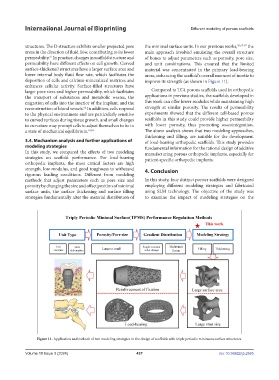Page 445 - IJB-10-3
P. 445
International Journal of Bioprinting Different modeling of porous scaffolds
structures. The D structure exhibits smaller projected pore the minimal surface units. In our previous works, 50,65-67 the
areas in the direction of fluid flow, contributing to its lower main approach involved emulating the overall structure
permeability. In practice, changes in scaffold structure and of bones to adjust parameters such as porosity, pore size,
61
permeability have different effects on cell growth. Curved and unit combinations. This ensured that the limited
surface-thickened structures have a larger surface area and material was concentrated in the primary load-bearing
lower internal body fluid flow rate, which facilitates the areas, enhancing the scaffold’s overall moment of inertia to
deposition of cells and calcium-mineralized matrices and improve its strength (as shown in Figure 11).
enhances cellular activity. Surface-filled structures have
larger pore sizes and higher permeability, which facilitates Compared to TC4 porous scaffolds used in orthopedic
the transport of substances and metabolic wastes, the applications in previous studies, the scaffolds developed in
migration of cells into the interior of the implant, and the this work can offer lower modulus while maintaining high
reconstruction of blood vessels. In addition, cells respond strength at similar porosity. The results of permeability
62
to the physical environment and are particularly sensitive experiments showed that the different cell-based porous
to curved surfaces during tissue growth, and small changes scaffolds in this study could provide higher permeability
in curvature may prompt cells to adjust themselves to be in with lower porosity, thus promoting osseointegration.
a state of mechanical equilibrium. 63,64 The above analysis shows that two modeling approaches,
thickening and filling, are suitable for the development
3.4. Mechanism analysis and further applications of of load-bearing orthopedic scaffolds. This study provides
modeling strategies fundamental information for the rational design of additive
In this study, we compared the effects of two modeling manufacturing porous orthopedic implants, especially for
strategies on scaffold performance. For load-bearing patient-specific orthopedic implants.
orthopedic implants, the most critical factors are high
strength, low modulus, and good toughness to withstand 4. Conclusion
rigorous loading conditions. Different from modeling
methods that adjust parameters such as pore size and In this study, four distinct porous scaffolds were designed
porosity by changing the size and offset position of minimal employing different modeling strategies and fabricated
surface units, the surface thickening and surface filling using SLM technology. The objective of the study was
strategies fundamentally alter the material distribution of to examine the impact of modeling strategies on the
Figure 11. Application and outlook of two modeling strategies in the design of scaffolds with triple periodic minimum surface structures.
Volume 10 Issue 3 (2024) 437 doi: 10.36922/ijb.2565

